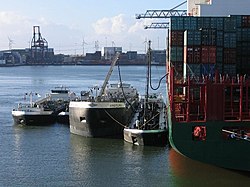IMO Net-Zero Framework
 The IMO Net-Zero Framework is a United Nations system to price maritime shipping emissions. It is set to apply from 2028 to shipping in IMO member countries, applying a carbon price of 100 USD per tonne of CO2 equivalent.[2][3] The Framework would be the first global pricing mechanism for emissions, to be administered by the United Nations's International Maritime Organization. It was drafted by Marine Environment Protection Committee Meeting 83 (MEPC83) and is scheduled for adoption by the IMO at an extraordinary meeting in October 2025.[2][3][4] Maritime shipping represents 3% of global greenhouse gas emissions. The Framework would apply to ships above 5,000 gross tonnage, which account for 85% of those emissions.[1][5] SystemIn the run-up to MEPC83, countries heavily debated what form the carbon pricing mechanism should take—a simple levy was favoured by around 60 island nations, while 16 mainly bigger emerging market economies favoured a carbon trading system in which clean ship operators could sell their rights to pollute to emissions-heavier ones.[6] In the end, countries agreed on a carbon trading system with two tiers, based on a proposal by Singapore. If ship operators were to fail to meet hard emission reduction targets, they would be able to buy cheaper extra certificates. If they were to fail easy emission targets, however, they would have to buy expensive extra credits. This system is designed to preserve decarbonisation incentives.[6][2] TargetsThe IMO Net-Zero Framework sets various intermediate targets on the way to net-zero shipping emissions by or around 2050.[2][6] Use of fundsUnder the Framework, companies would pay for their emissions to a newly created IMO Net-Zero Fund. The money would be used to mitigate negative impacts of climate change on vulnerable countries, including small island developing states (SIDS) and least developed countries (LDCs).[5] External links
See alsoReferences
|
||||||||
Portal di Ensiklopedia Dunia














